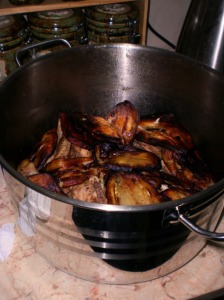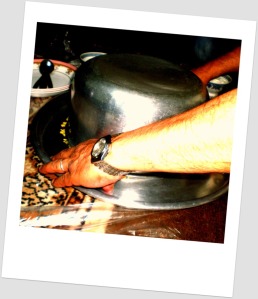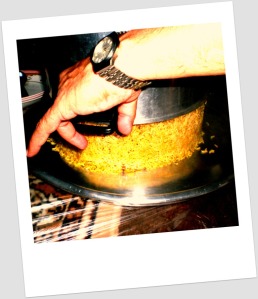Mtabbal: Easy Roasted Eggplant Dip
It’s been almost a year since I posted a recipe on this blog, during which I got engaged, then married – much sooner than was initially planned! -, and moved to Turkey to pursue a masters degree in Turkish Studies. It’s been a hectic but rewarding chapter of my life, and I’ve really missed posting new recipes throughout.
I finally decided to make the commitment to try and update the blog regularly again, even if the interval between posts is longer than I would like. I’ve received comments and feedback from family, friends, and readers, who have both asked for more recipes, and have given me useful suggestions on how to improve my posts!
To start off, I’m sharing a very simple recipe for mtabbal (sometimes spelled mutabbal), a creamy roasted eggplant dip that makes a great appetizer or a side to grilled meat dishes. A lot of non-Arabic speakers might be familiar with the term Baba ghannouj, which is basically very similar. I hope you enjoy it!
Mtabbal
Poke a few holes with a fork into two whole eggplants and roast in oven until the skins start to blacken. Peel them, discard skins, then mash up the insides in a bowl.
Add a spoonful of crushed garlic, some chopped parsley, three spoonfuls of tahini paste, the juice of two lemons, a bit of cold water, olive oil, and salt to taste. Mix well until all incorporated. Mix in some diced tomatoes if desired.
(If you don’t want to turn on your oven, you can roast the eggplants over a gas stove by placing the eggplant directly on the burner, and turning it every few minutes until cooked through.)
Keep Stuffing: Stuffed Eggplants
So to keep with the whole stuffing theme, I’m posting my aunt Hanan’s recipe for another kind of mahshi (stuffed vegetables): stuffed eggplants. The steps are very similar to the stuffed turnips recipe, but this one calls for less ingredients.
Eggplants occupy a special place in my heart. They have the most amazing taste, and a very rich, creamy texture. The simplest way Palestinians fix eggplant is to fry slices in hot oil till they turn golden, then garnish them with crushed garlic, lemon juice, and hot chili peppers. We serve this with bread, and you have the simplest, most delicious melt-in-your-mouth meal ever. Aside from that, there is a multitude of ways to prepare eggplant, ranging from layering it between tomatoes and ground beef like a casserole, to pickling it with a stuffing of walnuts and ground hot chilis.
It is such a versatile vegetable, and an absolute pleasure to consume.
Of course, in keeping with their love of stuffed things, my Khalili relatives make stuffed eggplants at least once a month (usually more, especially if my uncle Abed happens to get a good deal on eggplants at the vegetable market and comes home with 30 lbs of the stuff, to the exasperated groans of my aunt). So here you go: Batinjan Mahshi!
Note: In Palestine and Jordan, they use medium-sized to large, round-shaped eggplants for stuffing. When I made stuffed eggplants recently and took pictures for this blog, we only had a slender, long, kind on hand that was somewhat like a Japanese variety. Worked just fine.
Ingredients (serves approx 5)
1 batch of Best Mahshi Stuffing Ever
approx 9 lbs of eggplants
2/3 cup salt
6-7 cups pureed tomatoes (puree fresh tomatoes in a blender/food processor for best taste)
2 tomatoes, sliced
1 cup of water or stock (beef/lamb/chicken/vegetable)
salt&pepper to taste
Method
Cut the green tops off the eggplants. Using a ma’warah (coring tool), core the eggplants, removing as much of the insides as possible without poking a hole through the skin. If the eggplants are big enough, you might be able to use a spoon to help make the process faster.
As you can see, the eggplants we had on hand were this slender type that were unfortunately very difficult to core without poking holes through the skins or cracking them near the tops.
Discard the insides of the eggplants.

Try not to crack the eggplants near the "mouth," like I did here. Little cracks like these can expand with cooking and make the whole eggplant burst.
Next, fill a big bowl with water and add the 2/3 cup of salt, stirring until the salt dissolves completely. Take each eggplant and dunk it in the salty water, letting it become completely immersed, before removing it and putting it off to the side for stuffing.
Stuff the eggplants with the rice stuffing, making sure to leave about an inch worth of space at the top for the rice to expand upon cooking. Insert slices of tomato to plug the mouths of the eggplants so the stuffing doesn’t fall out.
You will need a large pot to cook the eggplants. When making mahshi, always remember that you have to make a protective layer at the bottom of the pot to keep the actual vegetables up off the direct heat. Some people slice up a potato and layer the slices at the bottom of the pot, others use soup or chop bones – this is definitely the best option because it gives the dish a lot of extra flavor, and the meat fans at your table can munch on the little bits of meat amid bites of eggplant and rice. If you don’t have bones on hand, and don’t want to cut up a potato, you can wash the green tops that you cut off the eggplants, and layer those down instead. (Just remember to fish them out of the pot later and not accidentally serve them!)
Arrange the eggplants in the pot.
Combine the pureed tomatoes, the cup of water or stock, and salt&pepper to taste, then pour the mixture over the eggplants in the pot. Place something heavy, such as a plate or bowl, on the eggplants to keep them pressed down, so they don’t float around in the liquid.
Cook on high heat until the tomato mixture starts to boil. Let boil for two minutes, then turn the heat down to medium-low. Cover the pot, and let it cook for about an hour to an hour and a half.
To serve: Arrange the eggplants on a serving platter; serve the tomato sauce in individual bowls too, for dipping the eggplants in. Also serve fresh yogurt on the side.












